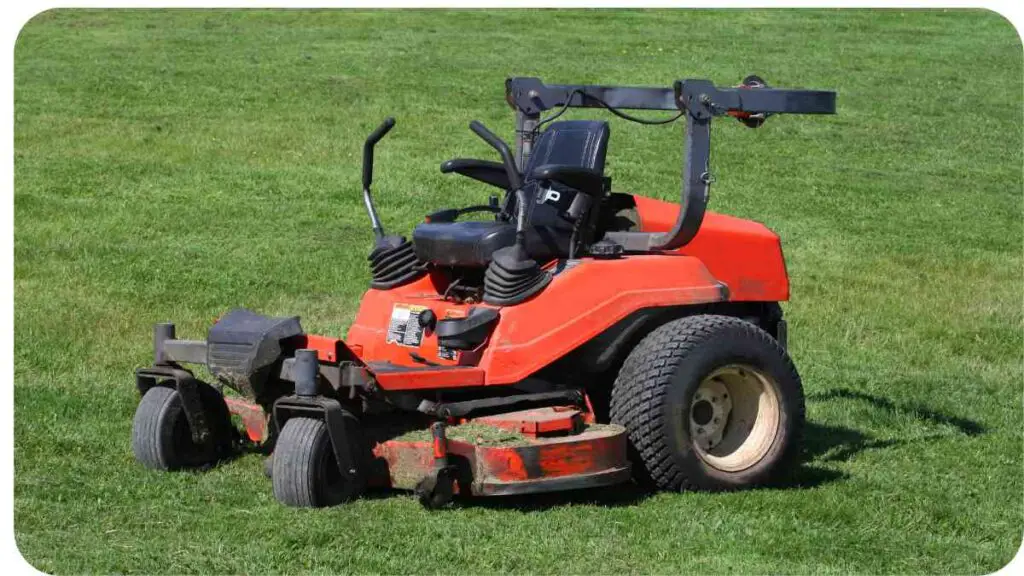Adjusting the belt on your Troy-Bilt lawn mower might sound like a chore, but it’s a crucial part of maintaining your mower’s performance. Whether you’re noticing some slipping, unusual noises, or just want to ensure your mower is in tip-top shape, a belt adjustment can make all the difference.
In this guide, we’ll walk you through the entire process, ensuring you have the knowledge and confidence to get the job done right. Ready to get started? Let’s dive in!
| Key Points |
|---|
| Regularly check and adjust the belt on your Troy-Bilt lawn mower to ensure optimal performance. |
| Proper belt tension is crucial for effective grass cutting and preventing damage to the mower. |
| Before adjusting the belt, always disconnect the battery and work on a flat surface for safety. |
| Use the tension adjustment bolts to fine-tune the belt; check for proper tension frequently. |
| Reassemble the mower carefully and test it to ensure everything is functioning smoothly. |
| Consult the mower’s manual and seek professional help if you encounter persistent issues or are unsure about the process. |
| Regular maintenance, including belt checks and cleaning, can extend the life of your mower. |
Why Adjust the Belt?
The belt on your Troy-Bilt lawn mower plays a critical role in transferring power from the engine to the blades. Over time, belts can stretch, wear out, or become loose, which can lead to decreased performance or even damage to your mower. Adjusting the belt ensures that it’s properly tensioned, which helps keep your mower running smoothly and efficiently.
When maintaining your lawn mower, knowing how to attach a mulcher can be just as crucial as adjusting the belt. This task ensures optimal performance and efficiency for your mower, enhancing your overall lawn care routine.
Tools and Materials Needed
Before we get into the nitty-gritty of adjusting your mower’s belt, let’s make sure you have everything you need. Here’s a quick rundown of the tools and materials that will make your task easier:
| Tool/Material | Purpose |
|---|---|
| Socket Wrench | To remove and tighten bolts |
| Screwdriver | For various adjustments |
| Pliers | To help with belt adjustments |
| Replacement Belt | In case your current belt is worn out |
| Lubricant | To keep moving parts functioning well |
Safety Precautions
Safety first! Before diving into any maintenance work, it’s essential to take some precautions to avoid injury and damage:
- Read the Manual: Familiarize yourself with your mower’s specific model and belt adjustment instructions.
- Wear Safety Gear: Always wear gloves and safety glasses to protect yourself from debris.
- Work on a Flat Surface: Ensure your mower is on a level surface to avoid accidents.
- Disconnect the Battery: To prevent accidental starts, disconnect the battery before you begin any work.
Step 1: Preparing Your Lawn Mower

Inspecting the Mower
Start by inspecting your lawn mower for any visible issues. Look for signs of wear and tear on the belt and surrounding components. If you notice any fraying or damage, it might be a good idea to replace the belt entirely.
For those looking to enhance their lawn care, understanding the best battery-powered lawn edger can complement the adjustments made to your mower. Choosing the right edger ensures a well-maintained and attractive lawn.
Disconnecting the Battery
To prevent any accidental starts, disconnect the battery before you start working on the mower. This simple step can save you from potential injuries and ensure a safer working environment.
Step 2: Accessing the Belt
Removing the Deck
To access the belt, you’ll need to remove the mower deck. Here’s a quick guide to help you with this step:
- Locate the Deck Bolts: Find the bolts securing the deck to the mower.
- Remove the Bolts: Use a socket wrench to remove these bolts.
- Lift the Deck: Carefully lift the deck off the mower, making sure not to damage any components.
Locating the Belt
With the deck removed, you should have clear access to the belt. It typically runs from the engine to the blades. Take a moment to familiarize yourself with the belt routing and tensioning system.
Step 3: Adjusting the Belt Tension
Using the Tension Adjustment Bolts
Most Troy-Bilt mowers come with tension adjustment bolts that allow you to fine-tune the belt tension. Here’s how to use them:
- Locate the Adjustment Bolts: These are usually found near the belt’s idler pulley.
- Adjust the Tension: Turn the bolts clockwise to increase tension or counterclockwise to decrease it. Make small adjustments and check the belt tension frequently.
If you find your grass burnt from excessive fertilizer, learning how to fix burnt grass is essential. This knowledge helps you restore your lawn and maintain its health after making necessary mower adjustments.
Checking for Proper Tension
To ensure the belt is properly tensioned, you should be able to press down on the belt with moderate pressure without it feeling too loose or too tight. A properly tensioned belt should have a slight amount of give but shouldn’t sag significantly.
Step 4: Reassembling the Mower

Reattaching the Deck
Once you’ve adjusted the belt, it’s time to reattach the deck:
- Position the Deck: Carefully place the deck back onto the mower.
- Secure the Bolts: Use your socket wrench to reattach the deck bolts securely.
Testing the Mower
Before you start mowing, test the mower to ensure everything is functioning correctly. Engage the blades and check for any unusual noises or vibrations. If everything seems to be working smoothly, you’re all set!
Common Issues and Troubleshooting
Belt Slipping
If you notice the belt slipping even after adjustment, it might be due to a worn-out belt or improper tension. Inspect the belt for wear and replace it if necessary. Also, double-check the tension adjustment to ensure it’s correctly set.
To achieve a lush green lawn, consider exploring the best ways to green up your lawn. Properly adjusting your mower is just one step towards improving your lawn’s appearance and health.
Unusual Noises
Unusual noises can indicate several issues, from misalignment to loose components. Make sure the belt is properly aligned and that all bolts and nuts are secure. If the noise persists, consult a professional for a thorough inspection.
Maintenance Tips
Regular Belt Checks
Regularly check your mower’s belt for signs of wear or damage. Doing so can help prevent issues before they become major problems and ensure your mower operates efficiently.
Cleaning the Mower
Keep your mower clean to prevent debris buildup, which can affect the belt’s performance. After each use, clean the deck and remove any grass clippings or dirt.
When to Seek Professional Help
If you’re unsure about any part of the adjustment process or if you encounter persistent issues, it’s best to seek professional help. A qualified technician can diagnose and fix problems that might be beyond your expertise.
If you’re planning to improve your lawn care, understanding how to write up a proposal for lawn care might include details about mower maintenance. This proposal can help you effectively manage and enhance your lawn care services.
Conclusion
Adjusting the belt on your Troy-Bilt lawn mower might seem like a daunting task, but with the right tools and a bit of patience, it’s a manageable job. Regular maintenance and timely adjustments will keep your mower running smoothly and extend its lifespan. Happy mowing!
Further Reading
- Lawn Mower Maintenance Tips
- How to Replace a Lawn Mower Belt
- Troubleshooting Common Lawn Mower Problems
FAQs
- How often should I adjust the belt on my lawn mower?
- It’s a good practice to check and adjust the belt tension at least once a season or if you notice any performance issues.
- Can I replace the belt myself?
- Yes, replacing the belt is a DIY task if you follow the manufacturer’s instructions and have the right tools.
- What are signs that the belt needs adjustment?
- Signs include slipping, unusual noises, or poor cutting performance.
- How do I know if the belt is too tight or too loose?
- A properly adjusted belt should have slight tension with minimal sag. If it’s too tight, it may cause excessive wear; if too loose, it may slip.
- What should I do if the belt keeps breaking?
- Check for alignment issues, inspect for worn components, and ensure proper tension. If problems persist, consult a professional.
Further Reading
Adjusting Drive Belt Tension on a Troy-Bilt
This guide provides a step-by-step approach to adjusting the drive belt tension on your Troy-Bilt lawn mower, offering practical advice for troubleshooting and fixing belt issues.
How to Change the Deck Belt on a Troy-Bilt Riding Mower
Learn the detailed process for changing the deck belt on a Troy-Bilt riding mower, with clear instructions to guide you through the replacement.
How to Green Up Your Lawn
Discover tips and techniques to improve the health and appearance of your lawn, ensuring a lush, green finish throughout the growing season.
FAQs
What is the purpose of the belt on my Troy-Bilt lawn mower?
The belt transfers power from the engine to the blades, enabling them to cut grass effectively. Proper belt tension ensures optimal performance and efficiency.
How do I know if the belt needs adjustment?
Signs that the belt might need adjustment include slipping, unusual noises, or poor cutting performance. Regular inspections can help identify issues early.
What tools do I need to adjust the belt on a Troy-Bilt lawn mower?
You’ll typically need a socket wrench, screwdriver, pliers, and possibly a replacement belt. Ensure you have the right tools for your specific mower model.
How often should I check the belt on my lawn mower?
It’s a good idea to check the belt at the beginning of each mowing season and periodically throughout the year. Regular maintenance helps prevent problems.
Can I adjust the belt myself or should I hire a professional?
You can adjust the belt yourself with the right tools and instructions. However, if you’re unsure or encounter persistent issues, seeking professional help might be a better option.

For 15 years, Hellen James has worked in the gardening industry as an expert and landscape designer. During her career, she has worked for a variety of businesses that specialize in landscaping and gardening from small firms to large corporations.

